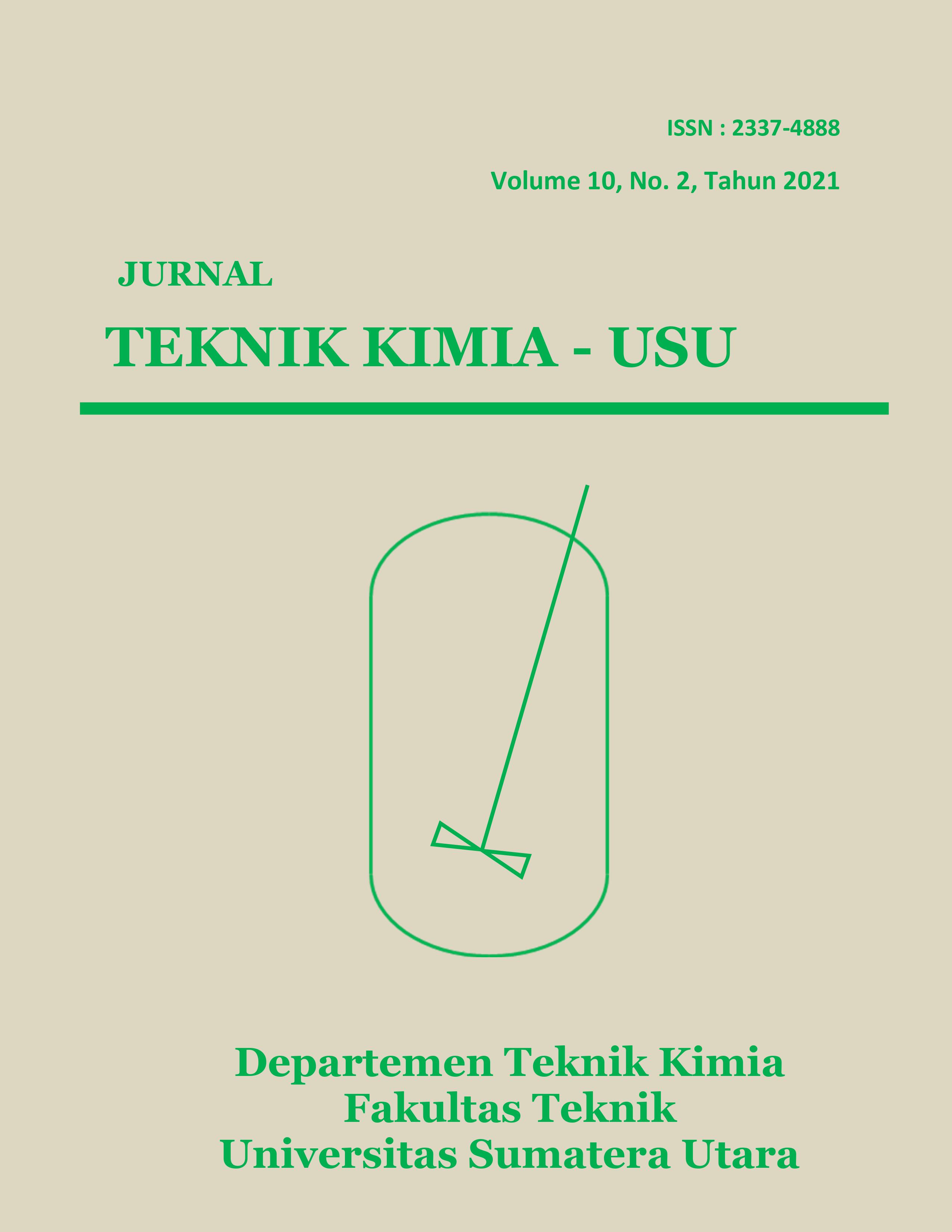Pemanfaatan Asap Cair Hasil Pirolisis Batubara sebagai Pestisida Organik pada Rayap (Coptotermes curvignathus Holmgren)
DOI:
https://doi.org/10.32734/jtk.v10i2.5604Keywords:
liquid smoke, pesticides, pyrolysis coalAbstract
Pyrolysis is a process of chemical decomposition of materials through a heating method in the absence of oxygen or a little oxygen. The utilizing coal as a raw material for making liquid smoke, it is hoped that it will be able to produce pesticides that have economic value and can be used as a termite exterminator. The use of coal as a raw material for making liquid smoke is expected to produce pesticides that have economic value and can be used as a termite repellent. This research aimed to determine the optimum concentration and time of liquid coal smoke as a pesticide against termite insect mortality (Coptotermes curvignathus Holmgren). The method used is the coal pyrolysis process at a temperature of 300 0C. The process of testing the mortality of termites with time and concentration variables. The determination of the liquid smoke content of coal is carried out by qualitative and quantitative analysis. The results showed that the optimum time for termite mortality was 25 minutes with an optimum concentration of 80%, where the termite mortality was obtained by 100%. Based on the results of UV/VIS Spectrophotometer Analysis, the sulfur content of liquid coal smoke was 46.92 mg/kg, and the degree of acidity (pH) was 3.00. The acidity content is high enough to allow pesticides from liquid coal smoke to be widely used in agriculture.
Downloads
References
M. Arman, A. Makhsud, A. Aladin, M. Mustafiah, and R. Abdul Majid, “Produksi bahan bakar alternatif briket dari hasil pirolisis batubara dan limbah biomassa tongkol jagung,†J. Chem. Process Eng., vol. 2, no. 2, p. 16, 2017.
I. Ishak, M. Wenny, and W. R. Sity, “Pemanfaatan asap cair tempurung kelapa sebagai pestisida organik terhadap mortalitas ulat grayak (Spodoptera Litura F.),†Jamb. J. Chem, vol. 1, no. 1, pp. 15–20, 2019.
F. Kasim, A. N. Fitrah, and E. Hambali, “Aplikasi asap cair pada lateks,†J. PASTI, vol. IX, no. 1, pp. 28–34, 2015.
Subiyakto, N. Asbani, D. A. Sunarto, and Sujak, “Efikasi pestisida alami kalsium polisulfida (Sulfur) terhadap tungau (Polyphagotarsoneum latus L.),†Agrovigor, vol. 9, no. 1, pp. 42–47, 2016.
M. Mustafiah, “Pemanfaatan Asap cair dari blending limbah biomassa cangkang sawit dan tempurung kelapa dalam secara pirolisis menjadi insektisida organik,†J. Chem. Process Eng., vol. 2, no. 1, p. 36, 2017.
Anonim, Laporan Akhir: Kajian Ketercapaian Target DMO Batubara Sebesar 60% Produksi Nasional pada Tahun 2019, BAPPENAS, Jakarta, 2016, p. 1–115.
T. Dickerson and J. Soria, “Catalytic fast pyrolysis: A review,†Energies, vol. 6, no. 1, pp. 514–538, 2013.
E. Sari et al., “Production of liquid smoke from the process of carbonization of durian skin biomass, coconut shell and palm shell for preservation of Tilapia fish,†IOP Conf. Ser. Mater. Sci. Eng., vol. 543, no. 1, 2019.
F. Swastawati, E. Susanto, B. Cahyono, and W. A. Trilaksono, “Quality characteristic and lysine available of smoked fish,†APCBEE Procedia, vol. 2, no. 2007, pp. 1–6, 2012.
E. A. Nego, Abdul Hapid, Muthmainnah, and Erniwati, “Jenis rayap yang menyerang rumah penduduk di Kecamatan Sidoan Kabupaten Parigi Moutong Sulawesi Tegah,†Jurnal Warta Rimba, vol. 8, no. 3, pp. 262–267, 2020.
I. A. Impact and N. Subekti, “Karakteristik populasi rayap tanah Coptotermes spp (Blattodea: Rhinotermitidae) dan dampak serangannya,†Biosaintifika J. Biol. Biol. Educ., vol. 2, no. 2, pp. 110–114, 2010.
R. S. Santoso, “Asap cair sabut kelapa sebagai repelan bagi hama padi Walang Sangit ( Leptocorisa oratorius ),†J. Sainsmat, vol. IV, no. 2, pp. 81–86, 2015.
Anonim, “Pestisida alami sulfur ampuh mengendalikan hama tungau,†Warta Penelitian dan Pengembangan Pertanian, vol. 4, pp. 12–14, 2011.
Downloads
Published
Issue
Section
License
Copyright (c) 2021 Jurnal Teknik Kimia USU

This work is licensed under a Creative Commons Attribution-ShareAlike 4.0 International License.

















